Super Pumas arriving in 2022, exclusive photos: "I put out fires while my child was in hospital"
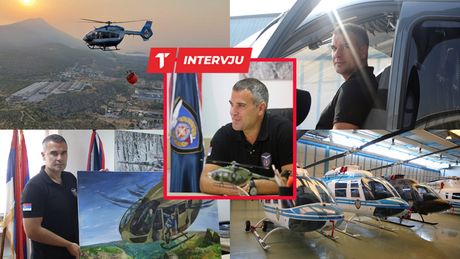
If he weren't a pilot, he would probably have practiced medicine, but fortunately the dream of a boy who grew up near the Lisicji Jarak airport, which is located in the immediate vicinity of the Batajnica military airport, came true. A man who flies, but is down to earth. He started his career at the airport in Podgorica, flew for the Serbian Army until 2008, when he transferred to the Helicopter Unit (HJ) of the SerbianMinistry of the Interior (MUP). Nenad Nedic, who speaks for Telegraf.rs in an interview, became the unit's commander in 2019.
This summer, he and his colleagues spent 18 days in the field putting out fires in Serbia, North Macedonia, Serb Republic, Greece... And he says, it's no big deal. In previous years, they would sometimes spend more than 30 days in the field. The pilot, who graduated from the Military Academy with an average of grade of 9, and as the second ranked, fought this summer along with his crews to save the lives and homes of people he doesn't even know, making every effort while his own child was in the hospital... How? Only he knows.
We spoke to him last week, immediately after his return from France, where Super Puma helicopters are being manufactured at the Airbus factory, which, as he reveals to us, will arrive in Serbia next year. We are also exclusively publishing photos of our Super Pumas from the plant in France, which will be flown by our pilots.
Commander Nedic also tells us that this unit is ready to fly to Kosovo and Metohija at any moment if the administrative line crisis calls for that. When asked to comment on his colleagues from Montenegro who refused to transport Metropolitan Joanikije and Patriarch Porfirije to Cetinje, he said that the HJ would have done it even if the route had been Belgrade-Cetinje...
He also told us that extinguishing wildfires this summer was more difficult for the HJ, specifically more demanding in North Macedonia than on Evia in Greece, and explained why. He also told us what the further plans for this unit, what they need, what other helicopters are being procured, but also whose weather forecast they rely on before taking off, what the unit's tasks are, what it's like to extradite convicted persons...
Since he personally flew Bear Grylls this summer while he was filming a show in Serbia, and will feature in it himself, he revealed to us what this adventurer - from whom he received a painting as a gift, an oil on canvas depicting the two of them on - is really like, but also what kind of passenger is President Aleksandar Vucic.
- What was the purpose of your trip to France?
- Last week, there was a regular meeting about the procurement of Super Puma helicopters for the needs of the Ministry of Internal Affairs of the Republic of Serbia. Also, the topic of one of the meetings was to precisely, once again, make a brief summary of the necessary activities that await us in the coming period, and above all I mean the start of training of aircraft mechanics, which is scheduled to begin on October 25, and in addition, to send once again the plan and program of flight crew training, that is, of the pilots which is scheduled to begin on March 7, 2022.
- In addition, we had the opportunity to see our three helicopters located in the Airbus production facilities. We concluded that the production process was going at its usual pace. There are no major difficulties, so we expect the delivery of the first Super Puma at the end of May or early June next year. The second and the third will most likely be delivered during August or early September next year.
- How many pilots will be trained to fly Super Pumas?
- For now, and according to the contract, the plan is that 6 pilots will complete the training on the helicopter in question. If you ask me: is that enough? Yes, I agree it is not enough. It's usual for this type of helicopter to have at least 3 crews per aircraft, which in this case would mean that we should send 18 pilots. The main reason why we cannot send more pilots is not financial, but the necessary requirements, set as a standard by the company, that is, the Airbus factory.
- Why exactly the Super Puma, what is it recognizable for and what are its characteristics?
- We conducted negotiations on the next type of helicopter that should become a part of the HJ fleet, and whose role would be to replace the existing Bell 212s, i.e. medium category helicopters. We also considered other manufacturers and models like the Agusta 139 type, produced by an Italian consortium. However, when we looked at all the operations that this helicopter should perform, that is, in order to perform them with greatest efficiency, we decided that the next helicopter that should be procured for the needs of our unit should be precisely the Super Puma.
They would have transported Joanikije and Porfirije to Cetinje
- If, God forbid, it were necessary, are you ready to go to Jarinje and Brnjak?
- Yes, we are ready, of course in coordination with our units of the Gendarmerie, and the Special Anti-Terrorist Unit, and that is what our training is for. Our work with these units is preventive in nature. Our main task when working with the Gendarmerie and the Anti-Terrorist Unit is the fight against terrorism. And then we function as a system. Our task is primarily to act and protect the territory of the Republic of Serbia.
- What do you think about your colleagues from Montenegro who refused to fly Metropolitan Joanikije and Patriarch Porfirije, how unsafe was that situation really, and what would you have done if entrusted with that task?
- I will only answer a part of the question, and you will understand me best from the answer I will give you. If they had offered us to do it, of course we would have agreed and I am sure we would have successfully completed the task even if the route was Belgrade-Cetinje.
If he wasn't a pilot, he would practice medicine
- Who is Commander Nenad Nedic and where does the love of flying come from?
- All people who are engaged in piloting, well not all of them, but a large percentage, I think even 90 percent are people who really like their profession. People don't do this job to satisfy something else, whether it is material or of some other nature. This job is done only out of love. And that love and that enthusiasm must be present for you to be successful in this profession.
- Now, if I were to talk about where the love for flying comes from, we will come to the postulate that has been present for a long time, and that is that boys dream of being maybe pilots and soldiers, girls dream of being ballerinas, princesses. In my case, I lived next to the Lisicji Jarak sports airport in the immediate vicinity of the Batajnica Military Airport. From an early age, I had the opportunity to see planes and helicopters flying over my house. Probably later, as I took step by step to to realize that boyhood dream, that love only grew and I think that this love has now created a passion for flying, that is, for being a pilot.
- The complete flight crew of this unit consists of former military pilots. Basically, we all completed the same training process, first the Military High School, then the Military Academy, so that currently 95% of the pilots in the unit had worked together at the Golubovci Airport. I mention this because my first job after graduating from the academy was at the mixed civilian-military airport in Podgorica, Golubovci.
- What would you be if you weren't a pilot?
- If I weren't a pilot? I don't know. I used to think about other possible professions as I was growing up. Whatever you achieved during your educational process did not guarantee the ultimate success, the realization of the ultimate goal, your boyhood dream, of becoming a pilot. Every year, you have medical checkups where you might not meet criteria and would have to look for an alternative to your further career. Also during the flight training process, there are various segments of training where you may not meet certain criteria and thus be removed from further flight training. I don't know now, when I was thinking about it then, maybe medicine was a consideration. Most likely medicine.
- You came from the Army, how different is your job there and here in the MUP, and do you have any regrets?
- First of all, I did not regret it. I spent a third of my life in the Army and I have very good experiences with the Army. I'm telling you, our entire flight crew is a former military collective. We've known each other for a long time, we grew up together. What is different may be the way the flight tasks are performed in the Army and in the Helicopter Unit of the Ministry. You only fly one type of helicopter in the Army. In the Ministry of the Interior, you fly an average of 4 to 5 types of helicopters, which gives you the opportunity to improve your skills. It is specific that in the HJ all pilots are trained to perform all types of flight operations - the use of the fire bucket, which we had the opportunity to do somewhat more intensively this year, the use of a side crane, work with special units.
- Our colleagues from the Army have their own type of tasks, they perform combat operations, because their helicopters are equipped that way. Over 50 percent of our tasks is helping the population, we are at the service of the citizens. Because, you know, a helicopter is always called in when others cannot come to the rescue or when no one else is able to provide adequate help. Then a helicopter is called in.
It's always a lesson with the president
- Who do you personally have not flown so far, but would like to?
- I don't have a preference. I am glad and consider it my personal satisfaction that my passengers have been our president, Patriarch Porfirije, other presidents, prime ministers of other countries.
- What kind of passenger is our President Aleksandar Vucic?
- Our president is a modest and measured passenger, but a passenger who knows the facts of geography, facts of history very well, so it often happens that during a regular flight he asks us which place we are flying over and we must always be ready to know, even if it's some small town or village. You never know when a question will be asked, so we have a little trepidation. But, of course, every time the president adds some historical facts, so we also get a type of education about what happened in Serbian history.
- So it's always a lesson with the president?
- Yes.
Fires in North Macedonia were more demanding
- Let's go back to the summer and the fires. You spent 18 days straight in the field with your crews putting them out. You were putting out wildfires in Serbia, the Serb Republic, North Macedonia, and Greece.
- My basic task, despite the fact that I am in a managerial position, where I am responsible for the staff of the Helicopter Unit, and therefore for the fleet of the unit itself, is primarily to perform flights. When you fly with our guys, all those pilots and helicopters don't know either your rank, or your title, or your current position, or your job. I think it's my place to be where they are, to be with them, and to carry out the tasks together in the best possible way, that is, as we are used to and the only way we are trained.
- So, we put 18 days together, however, it's not something new, something that members of the unit are not used to. In the past, there had been situations when we stayed in the field for more than 30 days with our helicopters, depending on which operation had to be carried out. What I am saying is that there's no time to think about things other than helping those people. You are indirectly witnessing a misfortune that has befallen them. The easiest thing is when forest fires are extinguished outside populated areas, when their households are not endangered. Already, a degree higher, and you are forced to fight for every house, for every household. You see all these people making great efforts to save their households, and in those moments you are forced to think only about how to help them, how to slow down the spread of that fire and give firefighters more time to put it out.
- And while you're putting out fires in Greece, you learn that your child is in the hospital. What it's like to fight fires, save lives and homes of people you don't know, while your child is treated in the hospital?
- We are already used to not allowing anything from the outside to disturb us when we perform our tasks. A helicopter is a very specific machine. Flying in itself is an unnatural environment for every person, you have to be concentrated at all times while you are in the air. Anything that can upset you and throw you off balance can negatively impact and lead to negative consequences, both for the helicopter itself and for the crew.
- I must emphasize that support, and above all I mean of the family, is extremely important in this line of work. A lot has to take the back seat in order to perform the task safely. This is exactly what happened to me while I was on assignment in Greece. Unfortunately, yes, I learned that my younger son had to be hospitalized. And, as you can guess, it's not easy at all. You're not there. One more reason for things to be harder for the wife, who, of course, played a key role at the time. She dealt with the problem on her own while I was fighting fires on Evia and the Peloponnese. I did not receive any objections. Only a well-deserved welcome and a strong hug after 18 days spent in the field. That's why she's a hero to me.
- Were the fires on Evia the most demanding task of your career?
- It may sound strange to you, but this year the more demanding fires and our deployment was in North Macedonia. I'll tell you why. In North Macedonia, we were sent to support the army of North Macedonia. However, at that time, North Macedonia had two functioning aircraft, two functioning helicopters, and there were cases when they were not able to fly due to technical problems, so we flew alone. We had difficulties coordinating with the forces on the ground because they are not organized like the Sector for Emergency Situations of our Ministry. It was an opportunity to pass on our positive experiences to them in order to make them more efficient, to make things easier for ourselves.
- In the area of Evia, it was a little more demanding for another reason, but above all I mean the organizational nature. The biggest problem when you go to a foreign country with aircraft is that your process and maintenance system is not present there, and aviation requires technical support and logistics in order for flights to operate smoothly. You do not know when and where even a minor malfunction will occur, which can complicate your operability. So, in terms of maintaining the aircraft themselves, it was more difficult in Greece, and in terms of straining the crew, it was more difficult in North Macedonia.
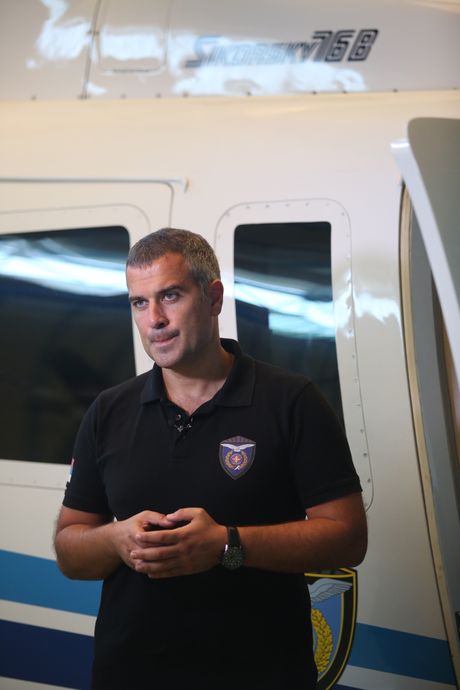
- What was the condition of the helicopters when they returned from Greece? You had to take water from the sea as well.
- What makes it difficult for us and what is different from what we are used to, although we had experiences because this unit in the past extinguished fires in the territory of Montenegro, when we also had to use sea water, is that salt water that doesn't suit neither helicopters nor water bomber planes, Canadairs. After each flying day, you have to dedicate yourself well to the maintenance of each helicopter, to wash and rinse air intakes, compressors, because it can have a very big negative impact on the engines themselves. This made it difficult for us, for our mechanics, who would be in the air for 6 or hours, then having to spend 2 or 3 more to prepare the helicopters for the next flying day and the next activity.
Recognition from fighter pilots
- The Greeks are more than happy with your deployment and that of the Sector for Emergency Situations. At one point you became brothers in a predicament, what was an especially touching moment?
- What is a little strange, but it is interesting to us airmen, in our aviation world. We were based at the Tanagra military airport, where their Mirage 2000 fighters are also based. It's very rare for fighter pilots to show recognition to us. When I say to us, I mean us helicopter pilots. This was exactly the case here. The commander of the fighter squad went with us on a mission and had direct insight into the way we perform this type of flight operation, extinguishing forest fires, and how other aircraft from other countries perform it, since it was definitely a multinational operation. And, for the first time, which is very important, the Republic of Serbia participated in such an operation, and that speaks especially about the state of affairs in the country, because the situation in the country indirectly reflects on the state of its aviation. If you are able to send aircraft, and I note that Serbia, besides Switzerland, is the only one that sent 3 aircraft to Greece, then that is great recognition for the Republic of Serbia, for our ministry and this unit.
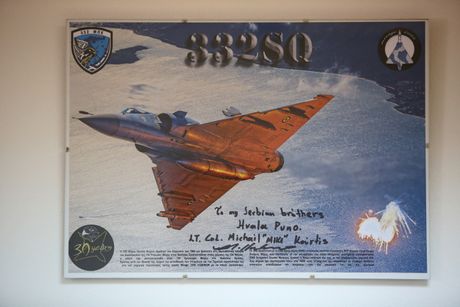
- When you asked me what touched me, it was exactly that gesture. It is standing on the wall, a photograph of a Mirage and below it the message of the commander who made an effort, so he wrote a part of the message in Serbian. It may be something trifle for some people, but for us it's a great thing, that someone though of it, that someone wanted to express their gratitude to us in that way.
- Should more helicopters have been sent to Greece, if you could have done it?
- We could have done that, although we always took care that a part of the fleet remained in the Republic of Serbia, because our primary role and function is not to extinguish forest fires. This is our activity in addition to a number of other activities, and you cannot bring the operational crew to such a level that because of one activity you cannot perform your regular tasks. You just mentioned our southern Serbian province of Kosovo and Metohija, for which we must always be ready, and have crews and aircraft ready. In addition, we are on duty around the clock for the needs of the Directorate of Civil Aviation to engage in search and rescue operations in case of potential plane crashes, so, yes, we had the opportunity, but we took care to send the necessary forces there that could help the Greek people and certainly leave other helicopters ready to perform other tasks in the Republic of Serbia.
Suburb of Athens burned down
- What remained with you from the Evia operation, the kind of thing we could not learn about and see here in media reports?
- It left an impression on me, since I had the opportunity to fly over Athens, where I actually saw, as well did my crew, that a suburb of Athens really was burning. In some later analyses, we realized that the fire on Evia and in Athens probably happened at the same time, during which they redirected all their forces to the defense of Athens, thus leaving Evia undefended. Because, if the fire really reached the suburbs of Athens, and Athens is a really big city, then it is very difficult to control such a fire later on.
- What left a little worrying impression on us is the communication between firefighters on the ground and firefighters in the air. There were difficulties, aggravating circumstances. We got the impression that air units were performing their own tasks, while the units on the ground their own. When we talk about such large fires, there must be coordination. That is why they expressed great gratitude to our firefighters from the Sector for Emergency Situations, because until their arrival, they were leaving their positions at the onset of darkness, so they were present in the field only during daytime. Of course, a fire of such capacity cannot be left to itself, and you cannot rely on controlling it during daytime and leaving it alone at night, because that rule is exactly the problem. And, it was our firefighters who spurred with their behavior, their sacrifice, other firefighters to follow their example. So, it seems to me that they saw the way we work.
- What was yet another aggravating circumstance for us is that our fuel was not close to the place where we extinguished fires, and also, there were situations when we did not even have water nearby. Then you lose your efficiency and your usefulness, because for everything to be as it should be, like had been the case in the Republic of Serbia, we had to have our fuel tank and our water pools. Then that cycle of taking in water, dumping it and taking it in again lasts 5 minutes. With 3 helicopters, you achieve the full effect. Of course, there was the problem of taking in water, we thought the water had to be taken in far away from the fire which again slows you down and there's the possibility of your task being reduced to an hour, a hour and 10 minutes, an hour and 15.
- Where there any situations when you were afraid for your own life or the lives of your colleagues?
- These are all experienced crews and what I avoided saying before, and now I use the opportunity, is that this unit really has the most experienced pilots. I have a number of arguments to defend my position and to justify it. These guys are well known, not only in the region, they are also known throughout Europe, they flew from the US, through Norway, Italy, France, Germany, Africa. What is very important for us is that we have achieved our reputation of sorts, but I repeat, it's the pride of all of us. Danger is present, especially when performing such tasks. First of all, we avoid passing through a cloud of smoke, because in order for the engines to work normally, they must have a normal air supply.
- Did you have to fly through clouds of smoke?
- Yes, we had to fly through smoke. It was happenning to us the most in North Macedonia when we had to defend those two villages. Then we simply made the decision that in order to help that population, we had to go low through the smoke. However, the mitigating circumstance was that we were the only ones present, which was not the case on Evia. At one point, there were over 20 aircraft on Evia putting out the same fire. When you now take into account that our 3 helicopters were led by a Greek helicopter, 4 Canadairs are operating above us, and behind us are other members of other forces, when you look at that, then this creates a big problem while passing through smoke, and visibility is reduced to 600 - 700 meters.
- Every year, Spain, since they have big problems with wildfires, usually has two or three helicopter accidents that occur, precisely because of reduced visibility, because participants in these operations cannot see, and everyone wants to help and fulfill the task, even to the point when the machine itself experiences some malfunction that initiates an incident.
- So, regardless of everything, North Maceodnia was more demanding?
- From the point of view of our flying profession, when we did the analysis, yes, North Macedonia was more demanding for us, and the efforts there were greater than was the case in Greece.
- How much water did you dump while putting out fires this summer?
- In those 18 days, we had 217 hours in the air. That's how much our helicopters spent in the air just to put out forest fires. If the standard is for helicopters to fly 300 hours a year, in such operations, this was a big effort in only 18 days. And about 740 tons of water were dumped. It wasn't more because of the problems I have pointed out to. The places where water was taken were very far from the place of the fire, and we couldn't supply fuel in the area where we were performing the operation. For example, it Negbine, on Tara, our tank was next to water tanks with members of the Emergency Situations Department who filled those pools every minute from a truck, and had the capacity of 40 tons, which allows you to take water in, dump it, and take it again in five minutes. Then you have the full efficiency of using a helicopter. In Greece and North Macedonia, that process often took 15, 20 minutes, which is a very long time.
Trump has a Sikorsky, the Queen did, but so does the HJ
- What is it that the Helicopter Unit, Donald Trump, and Queen Elizabeth have in common?
- They have a helicopter in common. Specifically, behind me is a Sikorsky 76 helicopter, which is currently in use by the Donald Trump Corporation as well. He has three identical helicopters in his fleet. Queen Elizabeth also used this type of helicopter for her transport until a couple of years ago. Also, Sheikh bin Zayed had a helicopter like this in his fleet in the past.
- By the way, a helicopter of this type, which is part of our fleet, is created strictly for performing flights for the purpose of transporting VIP passengers. It's characteristics are high cruising speed, its reliability. For many, it is one of the most beautiful helicopters ever built in the history of helicopter aviation.
- Who do you use it for?
- Whenever there is a need to transport VIP passengers, we use this helicopter. That is its primary purpose. If for some reason we cannot use it or it is undergoing regular servicing, then either a H145 or a Bell 212 is used.
- Where is the Helicopter Unit today compared to a decade or two ago?
- When you look at the fact that a decade ago there were only 2 or 3 pilots who had the greatest authority, and that is the traffic pilot's license, and that only a few flew in instrument conditions, that the average helicopter was below 60 percent functional and when you see that now the that is over 90 percent of the fleet, that 80 percent of pilots are trained to fly in instrument conditions and that we are the only ones that have pilots with the highest authorization and I'm talking about helicopter commercial aviation and that is a traffic pilot's license, and where only this unit has flight examiners, then you can clearly infer where the unit was a decade or two ago, and where it is now.
- We are currently in the HJ hangar, while works are under way to build a new one. When will it be completed?
- We are currently in the existing hangar of the Helicopter Unit, which was built 20 years ago. In 2001, there was a move into this new hangar, since the original one was destroyed during the NATO aggression against our country. Work on the construction of a new hangar complex has already begun. It will be an extension of the existing hangar. It will be slightly larger, and intended for the new helicopters, i.e. the Super Pumas.
- How many helicopters are here?
- There are currently 17 helicopters here and there are 3 more helicopters in the hangar across the street, because it's impossible to put them all in the existing hangar.
Everyone needs more young pilots
- What does the HJ lack, are there plans to buy other helicopters, besides Super Pumas?
- What the Helicopter Unit is missing at the moment are young pilots. This is the biggest problem, however, it's not only this unit that is facing this problem. It is faced by air units all over Europe, and even the US has a very big problem with attracting young pilots.
- What definitely awaits us in the future is the purchase of new helicopters other than Super Pumas, because the contract for the Super Pumas is already being realized, it's in the final phase, we expect them next year. Procurement of helicopters for putting out wildfires is currently being negotiated. We will see the intensity of those negotiations and we will see when the arrival of those helicopters is expected.
- If there's anyone to say if we need firefighting helicopters, especially after a summer like this, then it's you?
- We definitely need helicopters for firefighting, while noting that our existing helicopters, which were the backbone of our forces sent to the area of North Macedonia and Greece - were Bell 212s, that are 41 years old. However, due to regular servicing and good maintenance, they are able to perform this type of task. Also, the Super Pumas whose arrival we expect are capable of carrying fire extinguishing using water buckets of larger capacity, but it's certainly necessary to procure additional helicopters whose main role would be to put out fires.
- You mentioned that we need young pilots, how should we motivate them?
- What I think definitely stands as a fact and reflects the current situation, is that most young people are not very motivated to pursue a flying vocation. I don't know why, but I know that Germany has the same problem. This job must first be loved in order to do it. Maybe (the answer is) to get them acquainted in more detail with the specifics of the profession itself, with the way where they could be educated. Pilot training is very expensive, and not only is it expensive, it is a time consuming process. The maturing of a pilot, from basic to intermediate level of experience, certainly requires a period of 7 to 10 years, therefore it requires very large material resources, because a pilot costs the state of Serbia on average between 2.5 and 4 million euros.
- What is the world's best helicopter and is there such a thing?
- Just to avoid any confusion. With the arrival of Airbus, the new H145 helicopter, I once stated that it is the best in its class. That meant that category of helicopter. There are different helicopters. What distinguishes them is the maximum take-off mass, operations for which they are used, so as far as our unit itself is concerned - a light multi-engine helicopter that has found its excellent application in performing certain operations is the Airbus H145, but that only applies to that class helicopter. If you look at our Sikorsky 76, it belongs to a higher class of helicopters, we use it for VIP flights. The Super Pumas, which are medium multi-engine helicopters, have their purpose, which is extinguishing wildfires, carrying suitable cargo, transporting members of special units, and also belong to the very top.
- I can't determine which is the best helicopter because you try to use one helicopter operationally for a number of tasks, for several types of operations.
- But, what definitely distinguishes the fleet of the Helicopter Unit is that it has regularly maintained, fully working helicopters. They are the oldest state aircraft. Behind me are Bell 206 helicopters, who are my peers, 42 years old, they still fly and are used for those tasks for which they are intended. With the arrival of Super Pumas, this unit will stand out not only in the Balkans but in the whole of Europe, because if you look at the state of our fleet, we are one step ahead of the Austrian police, the Belgian, Swedish and Norwegian police forces. Before the start of the pandemic, helicopter units from Belgium and Austria expressed their desire to visit this unit and see if it's possible to establish some kind of cooperation that would be realized through various seminars, trainings, which they would conduct with us here or over there.
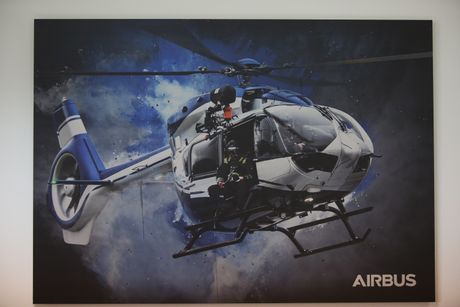
- Are there any indications that this will happen?
- What I definitely know is that in October we will have a visit from members of the Slovenian police helicopter unit who were instructed by the Airbus company because this (Serbian) unit has used the H145 helicopter most efficiently. They are coming to hear about our experiences because they are also in the process of modernizing the fleet, so one of the candidates that is seen as the successor to their existing helicopters is precisely the Airbus H145. I hope that after the end of the pandemic, cooperation will be established with other European Union countries, in order to exchange experiences, and what's very important, to reduce costs of this training process that is very expensive, simplify it and if we can, redirect the funds set aside for that towards something else.
- What are your regular and what are extraordinary activities?
- There is a very large range of flying tasks that this unit performs. If we were to say what are regular and what are extraordinary tasks, I can only sort them in relation to the time it takes to complete. We have tasks that are already planned, so we can consider them as regular. For example, coordinated training with members of the Gendarmerie, the Special Anti-Terrorist Unit, flights for the needs of the Border Police or perhaps our regular training flights. Everything else can be considered an extraordinary engagement of the HJ.
- We have a 24-hour on duty regime for the needs of the Civil Aviation Directorate, where we are under obligation to fly search and rescue operations within 30 minutes. Then, we have a contract signed with the Ski Resorts of Serbia and the Mountain Rescue Service, based of which during the tourist season in our mountains, if meteorological conditions allow, we send a helicopter to transport injured people who need to be rushed to a health facility.
- What is the riskiest type of operation for the Helicopter Unit?
- Every operation is a risk, but what is most risky in our opinion is extinguishing forest fires, rescue operations with the use of a side crane and possibly performing them during the night with the use of night flying goggles.
- Are your helicopters equipped with FLIR night vision cameras?
- Yes, we have FLIR cameras that are used for night flights. Also, in the camera itself is the option of thermal imaging to monitor facilities and terrain, so that it is used to control the state border, and potentially during other types of operations for the needs of other deparments in the ministry.
Extraditions of Elez, Vukotic
- And, what is the essence of you patrolling a settlement?
- At the moment, flights over settlements are not conducted so intensively, however, if there is a need to monitor a part of a city or a certain part of the territory, then we are deployed.
- One of the riskiest tasks are extraditions of convicted persons. Your unit was the one that extradited Darko Elez and Jovan Vukotic.
- In the last year and a half, this unit has had this type of operation twice. What distinguishes such flights is good preparation, because much of the preparation depends on you - how you take off, and the choice of the landing site, because often these flights are accompanied by an increased risk for both the aircraft and the helicopter crews. However, in good cooperation with the part of the ministry in charge of Interpol, as well as with our Special Anti-Terrorist Unit, there are no major problems in performing this type of operation.
- When performing such flights, you must take care that your flight is as covert as possible, and that it is as inconspicuous as possible, and that information is available to as few people as possible, i.e. only to those people who are involved in the task.
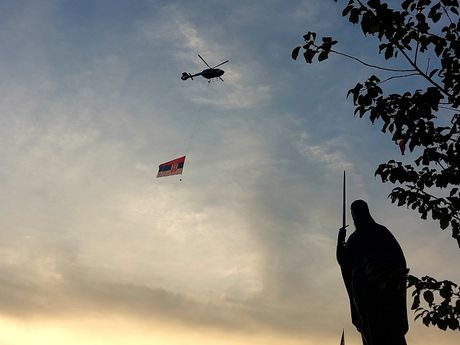
- Whose weather forecast does the HJ rely on?
- In order to take off, it's necessary to check meteorological conditions, on which it mostly depends whether a flight can be performed or not. We call SMATSE's meteorological service, which is located at the Belgrade airport, from which we receive information about the current situation and the development of the situation. We also call the meteorological service that is located at the HQ of the Air Force and Air Defense in Zemun. After receiving data from both services, it is up to the pilot to make a decision. His assessment, his perception of the meteorological situation gives the final word on whether the helicopter can take off.
- What is the instrument authority that only the HJ has in Serbia?
- It is, in fact, the possibility for your pilots to fly in conditions that are defined by the instrument rules of flying. In order for everybody to understand, every flight through the clouds, above the clouds, requires that type of authorization, according to the rules and regulations prescribed by the Serbian air authorities.
- You mentioned that the most important thing is that freezing doesn't occur?
- The process of ice formation is the most critical conditions in which a helicopter can fly. Many helicopters are not allowed to enter this type of cloud or fly in such an environment. By the way, it is most often present during late fall, during the winter and early spring. The Ministry decided to purchase the Super Pumas because they have a system of de-icing or anti-icing, which will allow us to be operational even in such flying conditions.
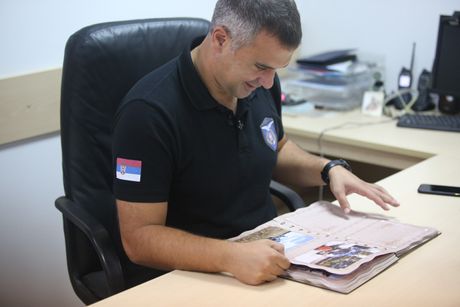
- Why do helicopter crashes happen?
- What is important and should be mentioned is that in recent years, helicopter accidents have been happening a little more often. Last year, the owner of Telenor was killed in a helicopter crash. In over 90 percent of cases, the human factor is the cause of the accident. Helicopters are regularly maintained and the possibility of a technical breakdown is possible, but very, very rare. Mostly it is the human factor or pilot error. Kobe Bryant was killed in the type of helicopter we own - Sikorsky 76. He was killed due to a pilot's mistake, who, because of reduced visibility, entered a cloud or the ground layer of fog and lost spatial orientation, that is, got disoriented and hit the ground.
A helicopter on Mt. Kopaonik during the season
- Will Serbia get helicopter emergency medical service, and when?
- The helicopter emergency medical aid is a very serious project that does not only include the purchase of helicopters. When we talk about the helicopter emergency service (HEMS), it's like when building a house. You must first have a good base, a good foundation, and then slowly start building up, and finally the roof. In this case, the roof is the purchase of a helicopter.
- What is definitely imperative now is that now all clinical centers must have an adequate place for takeoff and landing that allows operational use in our case, which means that they must have a heliport. With the construction of heliports, Serbia has started those basic preconditions so that maybe in the near future we will have emergency medical transports by helicopter, and that service must be closely connected to the 112 (emergency number) system. So, when you look at it, buying helicopters is only one part of starting and finishing this type of project.
- You said for the needs of the Ski Resorts of Serbia and the Mountain Rescue Service. What does that mean?
- This year, the public company Ski Resorts of Serbia, the Mountain Rescue Service and the Ministry of the Interior signed an agreement on cooperation which implies deployment of helicopters in order to transport injured persons from mountains during the season. In practice, this means that when the visits are more intense during the holidays, during the winter break, a helicopter from our fleet will be on duty either on Mt. Kopaonik or in the immediate vicinity, more precisely at the sports airport Trstenik, in case someone needs to be transported quickly to a medical facility. During other parts of the year, a helicopter will be based here at the Belgrade Airport because it takes 40 minutes from the moment the injury occurs to the establishment of a stable condition and transport to a trauma center, which how long it takes us to get from here to Kopaonik.
He flew Bear Grylls, was included in his show, they didn't need multiple takes for a single scene
- And Commander Nenad Nedic is in a way an actor, too. This year you flew Bear Grylls, who was filming in Serbia, so will the HJ be featured?
- Yes, this year we had the opportunity to work together on a project where, in fact, it was necessary to use our unit, our helicopter for the purpose of filming a new TV series which will be broadcast in late October, early November. We will have the opportunity to see both our helicopters and our crews as supporting actors in the said project.
- By the way, Mr. Bear Grylls is a real professional, a very measured man, very reasonable, his professionalism is characterized by the fact that his approach was always to listen to our advice, so that we could perform this type of operation in the best possible way for the purposes of what the director actually had in mind.
- I have to say that he is brave. The helicopter we are standing next to is equipped with a side crane. Exactly three shifts were filmed using a side crane, where Bear had to be hooked up and in two shots descend with a crane in order to save another actor, again, for the purposes of the series.
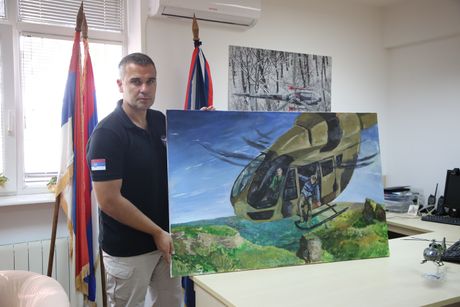
- You said he was brave. How was he with people, and did he really eat ironed sausages?
- He didn't eat ironed sausages (a southern Serbia specialty). He is a man who showed great understanding for the people he met with in the immediate vicinity, who wanted to have a picture taken with him. He was always in the mood to take a photo with the kids, so he left a very positive impression on me personally and on the members of my team.
- Considering what he's like, did you meet his expectations?
- What is proof that we fulfilled Bear's expectations is that we did not repeat any flights for any scene or frame. We planned everything well, carried it out precisely and by implementing that, we were not required to repeat a scene and record any more than once.
Video: Tragedy in Siberia, rescuers search for survivors: First videos after plane crash, 4 people killed
(Telegraf.rs)
Video: Darija Vučko o seriji "Tvrđava"
Telegraf.rs zadržava sva prava nad sadržajem. Za preuzimanje sadržaja pogledajte uputstva na stranici Uslovi korišćenja.

